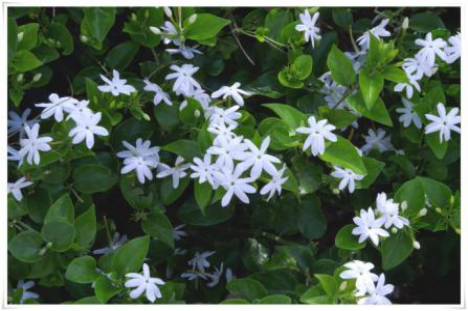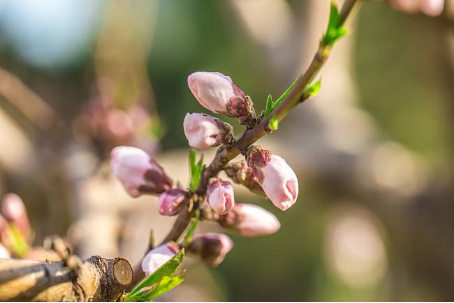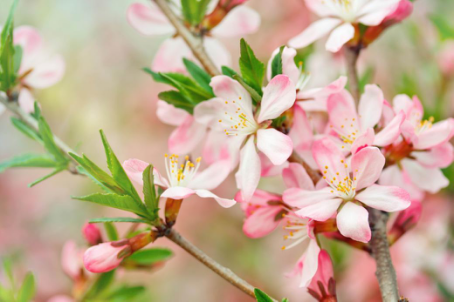The cultivation method of Jasmine mandshurica
Growth environment:
Hairy jasmine is suitable for growing in a warm and sunny environment, usually at an altitude of about 1000 meters. Because of the fear of the cold, if planted in cold areas, it needs to be planted in a greenhouse when overwintering. And Mao jasmine likes fertilizer and is suitable to grow in loose and fertile soil. The main way of propagation is in spring and summer, mainly by cutting propagation, selecting 1-year-old sturdy and full twigs as cuttings, taking plain sand as substrate, keeping the bed soil moist after cutting, and rooting in about 20-30 days.
Methods of reproduction:
Mainly cuttage propagation, carried out in spring and summer, hairy jasmine can propagate faster. In addition, it can also be propagated by striping.
Water and fertilizer:
When watering Mao jasmine, it is generally necessary to keep the basin soil moist and need appropriate watering. In summer, apply fertilizer twice, which can promote the growth of flower buds. Stop fertilizing in autumn. In relatively dry weather, you can effectively improve the humidity of the air by spraying water. Less watering is needed after autumn to ensure that the soil is not dry.
Light and temperature:
Mao jasmine likes a sunny and warm environment, so adequate light is essential when breeding. But in summer, we must pay attention to shade, especially in the high temperature, strong light at noon, more need to block the sun. Pay attention to heat preservation in winter, and it is best to keep the jasmine in a sunlit greenhouse for maintenance.

How to raise hairy jasmine? the breeding method of hairy jasmine
Hairy jasmine belongs to a kind of jasmine, which can treat diarrhea, abdominal pain, eye swelling, sores and other diseases, it can also be used as an ornamental plant, the flowers of hairy jasmine are white, giving people a sense of simplicity and elegance. Hairy jasmine emits a faint fragrance that can regulate people's mood. So how to breed hairy jasmine? let's take a look at how to raise hairy jasmine, how to raise hairy jasmine.
1. Growth environment of hairy jasmine.
Mao Jasmine likes warm, sunny environment and loose and fertile soil, likes fertilizer and is afraid of cold. Grows in an area 1000 meters above sea level. Cold areas need to spend the winter in a greenhouse. Stem erect or scandent, 2-5 m tall, covered with yellow-brown pilose. Leaves opposite, ovate, thinly leathery. Terminal compound umbel, white flowers, saucer-shaped, fragrant, flowering from winter to early spring. Sepals persist after flower fade. Mainly by cutting propagation, in spring and summer, one-year-old sturdy twigs were selected as cuttings, with plain sand as substrate, the bed soil was kept moist after cutting, and rooting took place in 20-30 days. Striping propagation is easier to root, and the plant is formed faster. Topdressing was applied once in about 10 days of the growing season, and stopped fertilizing after the beginning of autumn. If the greenhouse is sunny enough in winter, it can also blossom as long as the required temperature is maintained. Move out of the greenhouse in April, turn the basin and change the soil after pruning, put it in the shade, and transfer to normal maintenance after about 30 days.
2. How to raise hairy jasmine and the breeding method of hairy jasmine
Potted hairy jasmine, every 2-3 years, should turn the pot in March or after flowering. The basin soil can be prepared with 2 parts of garden soil, 1 part of compost and 1 part of sand.
Fertilization applied 20% cake fertilizer and water once a week, and increased phosphorus and potassium twice in summer to promote shoot enrichment and flower bud differentiation.
Watering to keep the basin soil moist, when the air is dry, it should be humidified by spraying water around noon. In early November, move into the sunny part of the greenhouse or sealed balcony, watering as appropriate, so that the soil is not too dry, so that it can blossom before and after the Spring Festival, so that fragrance overflows during the festival.
Temperature, light growing season, except for the midsummer noon to shade, other times should be given sufficient light.
Plastic pruning combined with turning basin should properly remove weak branches, withered branches, diseased branches and old roots, and cut short the flowering branches to stimulate the germination and growth of new shoots.
The main method of reproduction is cutting, and it can also be striped. The cuttings were cut from June to July, 3 branches of one-year-old branches were selected, 2 leaves were retained, and the cuttings were placed in the sand, shaded and moisturized, and rooting for about 30 days. Striping is also easy to take root and survive, the method is the same as the general crimping.
How to raise Mao jasmine, the breeding method of Mao jasmine seems simple, but it needs fine care when breeding. If you want to know more about Mao jasmine, please pay attention to the hot agricultural materials information.
Culture methods and matters needing attention of Mao jasmine Chinese scientific name Mao jasmine
Latin name Jasminum multiflorum (Burm. F.) Andr.
Also known as hairy calyx Jasminum, Jasminum multiflorum
Binomial Jasminum multiflorum
The plant kingdom.
Phylum angiosperm
Dicotyledonous class
Subclass synpetalous flower
A transitional flower order.
Suborder Oleaceae
Oleaceae
Subfamily Jasmininae
Family element Xin clan
Belongs to the genus Genus
Seed hair jasmine
Distributed in India, Southeast Asia and China.
The growing place grows in an area 1000 meters above sea level.
The national flower of Indonesia.
(scientific name: Jasminum multiflorum (Burm.) F.) Andr.) originated in India. The flowers of Mao jasmine are white and fragrant, with a long flowering period like jasmine, and bloom in winter and spring, so it is suitable for potted interior decoration. Mao Jasmine is the national flower of Indonesia. Distributed in India, Southeast Asia and Chinese mainland, growing at 1000 m above sea level. The main treatment of dysentery and abdominal pain, eye swelling pain, sores, swelling and other diseases; white fragrance, can be used as ornamental plants.
1. Morphological characteristics.
Climbing shrubs, 1-6 m high. Branchlets slender, curved, Terete, densely yellowish brown tomentose, glabrescent. Leaves opposite or subopposite, simple, leaf blade papery, ovate or cordate, 3-8.5 cm long and 1.5-5 cm wide, apex acuminate, acute or obtuse, base cordate or truncate, smooth or pubescent above, sparsely pubescent to densely tomentose below, veins sometimes sunken above, raised below, lateral veins 3-6 pairs; petiole 5-10 mm long, articulated near base, tomentose.
Cymes capitate or densely paniculate, terminal or axillary, densely yellowish brown tomentose; pedicels short or absent; flowers fragrant; calyx tomentose, lobes 6-9, conical, 2-6 mm long; Corolla white, salverform, Corolla tube 1-1.7 cm long, 2-3 mm in diameter, lobes 8, oblong or narrowly elliptic, 1-1.4 cm long, 4-6 mm wide. The fruit is oval and brown. The florescence is from October to April of the following year.
2. Growth habits
Like warm, sunny environment and loose and fertile soil, like fertilizer, afraid of cold. Grows in an area 1000 meters above sea level. Cold areas need to spend the winter in a greenhouse. Stem erect or scandent, 2-5 m tall, covered with yellow-brown pilose. Leaves opposite, ovate, thinly leathery. Terminal compound umbel, white flowers, saucer-shaped, fragrant, flowering from winter to early spring. Sepals persist after flower fade. Mainly by cutting propagation, in spring and summer, one-year-old sturdy twigs were selected as cuttings, with plain sand as substrate, the bed soil was kept moist after cutting, and rooting took place in 20-30 days. Striping propagation is easier to root, and the plant is formed faster. Topdressing was applied once in about 10 days of the growing season, and stopped fertilizing after the beginning of autumn. If the greenhouse is sunny enough in winter, it can also blossom as long as the required temperature is maintained. Move out of the greenhouse in April, turn the basin and change the soil after pruning, put it in the shade, and transfer to normal maintenance after about 30 days.
3. Distribution
Distributed in India, Southeast Asia and Chinese mainland all over the country and other places, widely cultivated in China and all over the world.
- Prev

How to make Peach Blossom Bonsai
In the production of ornamental peach blossom bonsai, first of all, in modeling, reasonable pruning should be carried out according to the growth of plants, to ensure that the twists and turns of the branches are different, but also to remove messy branches in time to maintain the beauty of the bonsai. Plastic surgery is also essential, but also according to the needs of some small accessories in the basin.
- Next

Bonsai production
So how to make peach blossom bonsai? First of all, we should choose the peach blossom varieties and reasonable branches which are suitable for bonsai. The ornamental peach blossom bonsai should be pruned reasonably according to the tree potential and growth condition to ensure the twists and turns of the branches, cut off the branches that affect the tree shape in time, and keep the bonsai appearance beautiful.
Related
- Fuxing push coffee new agricultural production and marketing class: lack of small-scale processing plants
- Jujube rice field leisure farm deep ploughing Yilan for five years to create a space for organic food and play
- Nongyu Farm-A trial of organic papaya for brave women with advanced technology
- Four points for attention in the prevention and control of diseases and insect pests of edible fungi
- How to add nutrient solution to Edible Fungi
- Is there any good way to control edible fungus mites?
- Open Inoculation Technology of Edible Fungi
- Is there any clever way to use fertilizer for edible fungus in winter?
- What agents are used to kill the pathogens of edible fungi in the mushroom shed?
- Rapid drying of Edible Fungi

